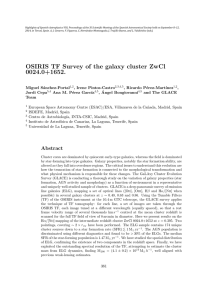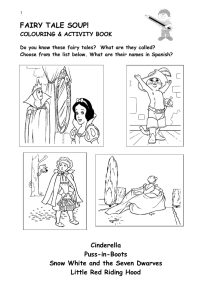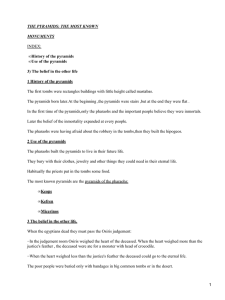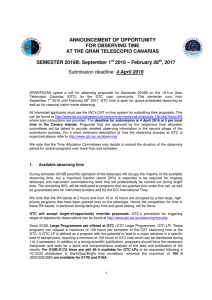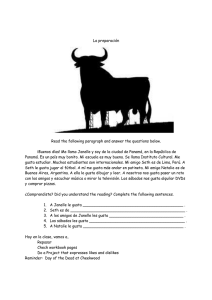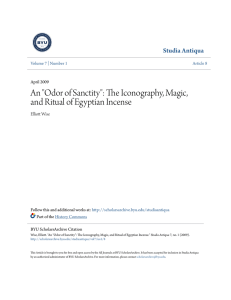The symbolism of the Djed-pillar in The Tale of King Khufu and the
Anuncio
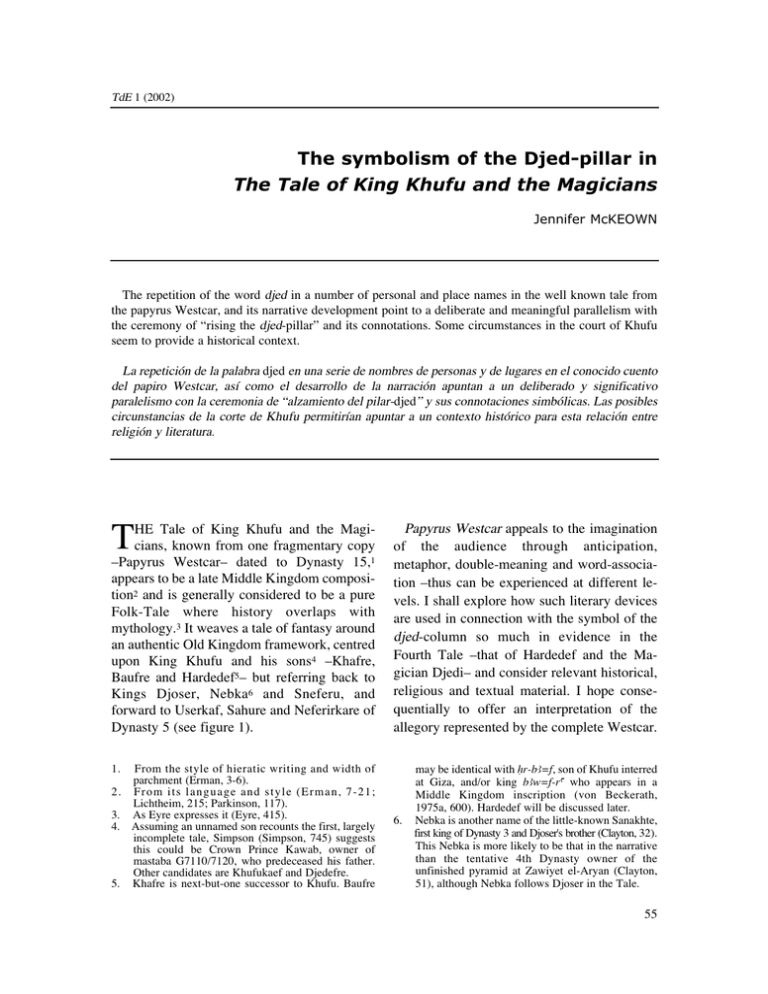
TdE 1 (2002) The symbolism of the Djed-pillar in The Tale of King Khufu and the Magicians Jennifer McKEOWN The repetition of the word djed in a number of personal and place names in the well known tale from the papyrus Westcar, and its narrative development point to a deliberate and meaningful parallelism with the ceremony of “rising the djed-pillar” and its connotations. Some circumstances in the court of Khufu seem to provide a historical context. La repetición de la palabra djed en una serie de nombres de personas y de lugares en el conocido cuento del papiro Westcar, así como el desarrollo de la narración apuntan a un deliberado y significativo paralelismo con la ceremonia de “alzamiento del pilar-djed” y sus connotaciones simbólicas. Las posibles circunstancias de la corte de Khufu permitirían apuntar a un contexto histórico para esta relación entre religión y literatura. HE Tale of King Khufu and the Magicians, known from one fragmentary copy –Papyrus Westcar– dated to Dynasty 15,1 appears to be a late Middle Kingdom composition2 and is generally considered to be a pure Folk-Tale where history overlaps with mythology.3 It weaves a tale of fantasy around an authentic Old Kingdom framework, centred upon King Khufu and his sons4 –Khafre, Baufre and Hardedef5– but referring back to Kings Djoser, Nebka6 and Sneferu, and forward to Userkaf, Sahure and Neferirkare of Dynasty 5 (see figure 1). T 1. 2. 3. 4. 5. From the style of hieratic writing and width of parchment (Erman, 3-6). Fr o m its la n g u ag e a n d s ty le (E rma n, 7-21; Lichtheim, 215; Parkinson, 117). As Eyre expresses it (Eyre, 415). Assuming an unnamed son recounts the first, largely incomplete tale, Simpson (Simpson, 745) suggests this could be Crown Prince Kawab, owner of mastaba G7110/7120, who predeceased his father. Other candidates are Khufukaef and Djedefre. Khafre is next-but-one successor to Khufu. Baufre Papyrus Westcar appeals to the imagination of the audience through anticipation, metaphor, double-meaning and word-association –thus can be experienced at different levels. I shall explore how such literary devices are used in connection with the symbol of the djed-column so much in evidence in the Fourth Tale –that of Hardedef and the Magician Djedi– and consider relevant historical, religious and textual material. I hope consequentially to offer an interpretation of the allegory represented by the complete Westcar. 6. may be identical with Hr-bA=f, son of Khufu interred at Giza, and/or king bAw=f-ra who appears in a Middle Kingdom inscription (von Beckerath, 1975a, 600). Hardedef will be discussed later. Nebka is another name of the little-known Sanakhte, first king of Dynasty 3 and Djoser's brother (Clayton, 32). This Nebka is more likely to be that in the narrative than the tentative 4th Dynasty owner of the unfinished pyramid at Zawiyet el-Aryan (Clayton, 51), although Nebka follows Djoser in the Tale. 55 Figure 1 The hieroglyphic biliteral Dd representing the djed-column of Osiris is used as the phonetic determinative of Ddi, meaning "to be stable, enduring",7 and in the later , and . variant writings8 In the Fourth Tale the appearance of Dd in the names Ddi, Djedi (the Magician), Dd-snfrw, (where Djedi lived9), r(w)d-Ddt Ruddjedet (mother of the 5th Dynasty kings) is surely deliberate to invoke associations with this ancient symbol. The djed-pillar was a prehistoric fetish, a wooden column imitating a bundle of stalks tied together10 –probably the last sheaf of corn to be cut at harvest-time– which in the ancient world was believed to contain the retreating spirit of the corn thus treated in a special way. The ceremony of Raising the Djed-pillar 7. 8. 9. 10. 11. 12. 13. 56 Gardiner, 1957, 502 and Faulkner, 1962, 325. Faulkner, 1962, 325. Town near the pyramid of Sneferu at Meidum (Kaster, 263). Gardiner, 1957, 502; Posener, 1962, 64-65; Shaw & Nicholson, 86, 213-214. Watterson, 55-56; Rundle Clark, 235-6; Altenmüller, 1975a, 1100-1102. Of many variant writings for Ddw. See Collier & Manley, 41. At Ddw, Osiris supplanted the indigenous god Andjety and took over his royal insignia of crook, flail and probably originated as a pre-historic postharvest ritual to re-vitalise the corn spirit. As Egyptian theology developed Ptah, then Osiris (as chthonic fertility-god and essence of all eternal life) became associated with the djed, and Raising the Djed-pillar with the resurrection of Osiris. The djed was treated as a living god; it was adorned with loin-cloth and feathers, and human eyes painted in.11 Two early cult-sites for the djed-pillar were the Western Delta towns of , (11th-mid 12th dynasty writings), (late 12th dynasty12) Ddw,13 now Busiris, and Ddt now Mendes.14 Although the Cult of Osiris was established by Dynasty 5 at the latest,15 the identification of Osiris with the djed-pillar cannot be shown conclusively until Dynasty 18. The Theban atef double-plumed crown. Later, when the myth of Osiris's dismemberment developed, Ddw claimed to be the burial-place of Osiris's backbone and the djed-pillar became the embodiment of this sacred relic. (Shaw & Nicholson, 213-214; Watterson, 56). 14. The ram-god bA-nb-Ddt "manifestation of the Lord of Djedet" was known here from Dynasty 2 (Shaw & Nicholson, 181). 15. Griffiths, 21-24 and 68; Rundle Clark, 98. Figure 2: Djed-columns supporting an arch as used in the architecture of a window, thus acting as a sky-support. Wall decoration in Step Pyramid (Rundle Clark, 236). tomb of Kheruef (TT192) has splendid reliefs16 of Amenhotep III offering to the Osirian djed17 (fig. 4); also of this king erecting the djed-pillar (fig. 5). The texts (Appendix I) tell us that the king himself performs the ceremony in order that the god Sokar-Osiris might grant favourable conditions for the impending celebration of Amenhotep's Sed-festival.18 Van der Vliet (406-7) points out that the specific occasion here for Raising the Djedpillar exemplifies the general occasion of providing a "Time boundary" to separate one era from another -e.g. to close Temple Festivals on the final day. The djed standing upright implies continued life and stability in the world.19 Kings may first have set the djed-column upright in Memphis during the Old Kingdom (Sethe, 156) but the earliest textual evidence comes from the Middle Kingdom. The 11th/12th Dynasty Coffin Texts, relate occasions of Raising of the Djed to certain times and places connected with the OsirisHorus-Seth myth, when the ceremony signified the Triumph of Osiris over his enemies.22 "O Thoth, vindicate Osiris against his foes in (...) the great tribunal which is in Khem on that night of erecting the djed-pillar in Herwer (...) the great tribunal which is in Pe and Dep on that night of erecting the two djedpillars...”. "O Thoth vindicate Osiris against his foes in (...) the great tribunal which is in Djedu on that night of erecting the djedpillar".23 As is clear from the above iconography, Raising the Djed-pillar not only symbolised the resurrection of Osiris but, with king as Enactor, served as a metaphor for the continuing stability and endurance of the monarchy. The djed-pillar has been used in royal architecture as "cosmic pillars" or "sky supports" since Dynasty 2,20 being particularly evident in Djoser's funerary complex (see Figures 2-3).21 The same mythology dominates the Royal Cult of Succession and directly links the king with Raising the Djed-pillar –notably in the Ramesseum Dramatic Papyrus24 discovered in a tomb dated to Amenemhet III. 16. Brugsch, 1190-1196; Oriental Institute of Chicago, 58 ff and plates 52-57. 17. Osiris is named by the head of the Personified djedpillar in Chart 2. In Plate 57, Amenhotep's daughters "adore Ptah-Sokar, the djed-pillar of Osiris". 18. Oriental Institute of Chicago, 59-60; van der Vliet, 406. 19. To be upright is to be alive, to have overcome the inert forces of death and decay (Rundle Clark, 236). 20. A stela of Khasekhemui has a djed-column support (Rundle Clark, 237). 21. Where they, together with Tyets (knots of cloth or leather, the symbol of Isis), were used to frame the Royal Name enclosure vertically. Rundle Clark, 236-237, gives a detailed explanation of the symbolism of the djed-pillar in delimiting and guaranteeing the space of air and world in which the king's authority holds good. He believes this is the origin of the cartouche. 22. Van der Vliet, 410-411; Altenmüller, 1975a, 1101. 23. De Buck, IV, 332, 335; Faulkner, 1973, 272-3. 24. Altenmüller, 1975b, 1132-1139; Sethe, 1928. 57 Figure 3: Djed columns supporting the world space occupied by the name of the Zoser (Rundle Clark, 137) This sacred25 work honours Senusret I but may have older origins.26 It has both funerary and dynastic concerns and seems to be a "Coronation Drama" performed at the Sedfestival to re-enact the royal accession ceremonies. It is played before a statue of the (deceased?) king onlooking from a boat.27 Scenes 12-15 and vignettes 7-9 (fig. 4) involve the djed-rituals and reveal that a) a goat and a goose are killed and their heads offered to the djed. These heads represent the head of Seth (twice); b) the djed carrying an imA-branch28 is raised by the king's issue (or new king?) and a cord attached to it. The accompanying text identifies the djed as Seth and the imA-branch as Osiris. Thus Raising the Djed causes the imA (Osiris) to rise over the djed (Seth) and symbolises the Triumph of Osiris over Seth.29 writings are known from Dynasty 5/6 inscriptions.31 Both also contain the biliteral Dd: and . Curiously, the Prince's name in pWestcar is written Hr-dd=f, without the djed32 column, whereas the listener might expect to hear . This appears intentional and causes me to pose the question "Why did Hardedef need to go in search of the djedpillar he lacked?". For that indeed is what he did in fetching Djedi who is not only eponymous with -but a personification of- the djed. Returning to The Tale of Hardedef. Prince Hr-Dd=f is an historical figure. In his mastaba . Variant at Giza, his name was written30 Hardedef finds a prostrate djed-pillar; Djedi is "lying down, inactive" (line 7.15). Interestingly sDr has the same root as sDrt the Festival of Laying (Osiris) to Rest.33 We may have anticipated Djedi to be already dead from his immense age34 and the funeraloffering quantities of food he consumes every day (lines 7.2-7.3). The djed-deity, however, might expect to receive such offerings daily! 25. The cursive hieroglyphs and retrograde writing of hieroglyphs in columns are typical of religious documents used in temples. 26. Sethe, 98, suggests Dynasty 1, but Altenmüller, 1975b, 1139, considers Dynasty 5/6 to be the earliest likely date because of the strong Osirian overtones. Senusret is named on the papyrus but not as the king in the text. 27. Altenmüller, 1975b, 1138. 28. The imA-tree may be a date-palm, Gamer-Wallert, 54. 29. Sethe, 48; Altenmüller, 1975a, 1101-1102. In a sense, the Djed is Seth when prostrate and Osiris when upright. 30. Reisner found his mastaba (G7210/7220) in 1926 in the Giza Necropolis. It had been desecrated -the lacuna could be D46 or A50. (Brunner-Traut, 7; Drioton, 46). 31. Junker, 26; Goedicke, 45. These are from stele of followers of the cult of the deified Hr-Dd=f, who "adored" him or "were revered before" him. 32. That is the writing in The Instruction of Prince Hardjedef and other literature quoting him are similar e.g. (Brunner-Traut; Posener, 1952, 113) is no surprise since the versions known of these texts all post-date pWestcar. 33. Faulkner, 1962, 259. 34. His 110 years was the age all Egyptians aspired to but probably never reached. 58 Figure 4 Hardedef addresses him as imAxy, the usual term for the revered dead. Djedi has Osirian attributes –the power to restore life– and immortality: "he knows how to put on a head again that has been cut off" (line 7.4); "Your condition is like one living beyond (the) years (of the) state of death, burial and interment ... one who sleeps until dawn devoid of disease". (Hardedef to Djedi, lines 7.177.19). The word nis used when Hardedef "summons" Djedi to Khufu (line 7.20) also has the meaning "to evoke (the funeral repast)". Hardedef tells Djedi he "will eat dainties of what the king gives ... that (the king) may conduct him in due time to his forefathers in the necropolis". Offering formula language to the still-living? Or might the listener have images of the king offering to the djed and performing the associated rituals? The ambience is mortuary throughout but careful choice of words develops associations with immortality, Osiris and the djed-pillar. "Disease" here is written not xAyt but xAt, homophonous with a word for "corpse",35 word-play strengthening our feeling that Djedi is immune from death. The symbolism reaches its zenith in Line 8.2, when Hardedef "helps Djedi up".36 Literally translated, saha.n=f sw means "he 35. Faulkner, 1962, 183.35. 36. Translated thus by both Lichtheim, 218, and Kaster, 264. 59 Figure 5 causes him to stand". saha also means "raise up" or "erect (buildings)".37 I find it compelling that this is a carefully worded metaphor for Hardedef Raising the Djedpillar, which is always written saha Dd in the textual sources. Possibly, an anticipatory verbal echo of this event exists in the construction aha pw ir.n (name) "There was a standing which (name) made" used to introduce each tale and when Hardedef first finds Djedi. The metaphor continues as the now upright and re-vitalised djed walks to the boats, his accompanying children and books (lines 8.28.4) possibly developing associations with the 37. Faulkner, 1962, 215. 60 Children of Horus and Thoth –important players both in Royal Funerary Ceremonies and in the Ramesseum Dramatic Papyrus. At Khufu's Court, Djedi was "dragged in"38 before the king (line 8.10). sTA –appropriate for a pillar– also implies the disrespect shown by Khufu for the djed. They met in the wAxy , the "pillared forecourt" of the palace ironically having papyrus-columns. But is the djed-pillar unknown at the palace? Khufu, unlike Hardedef, did not recognise Djedi and his attributes at the start of the Tale (lines 6.24-7.6). Even after Djedi has demonstrated his ability to join the severed heads of geese and ox (lines 8.13-8.25), Khufu appears blind 38. A better translation for sTA (Faulkner, 1962, 255) than Lichtheim's "ushered". to his Osirian qualities. Djedi's display of magic resonates with echoes of the djed-scenes (12-16) of the Dramatic Papyrus (cf. supra and figure 5). The close parallels and colourful additions are analysed in Appendix III. Khufu's later blackened reputation among the Greeks probably stemmed from this episode of pWestcar. The king's callous order to decapitate a prisoner for Djedi's demonstration of magic and his lesser concern with the miraculous regeneration of the dead than his obsession with perfecting his Pyramid39 gain him no sympathy. We are not surprised at Djedi's prophecy that this tyrant's Dynasty will give way to that of Ruddjedet's children (lines 9.1-9.14). Khufu is dismayed; at this point perhaps he becomes aware that his failure to encompass the djed has forfeited his Dynasty stability and endurance. Djedi is assigned to dwell with Prince Hardedef, his rations enhanced40 (line 9.19-9.21) –strangely now including leeks!41 suffixed their names with -re (see Figure 1). I believe my interpretation of the symbolism of the djed-pillar offers some clues. The missing first section of the Papyrus may explain why the four princes were relating their tales of magic to Khufu. Superficially it is to entertain him but, at a deeper level of interpretation, were they attempting to deal with some crisis in the monarchy?43 The Fourth Tale is redolent with imagery of Raising the Djed-pillar, which rite Van der Vliet argues could be evoked in any political or mortuary situation where continuity is threatened,44 including the legitimacy of royal succession. The previous Tales are linked to the Fourth through (a) the introductory construction aHa pw ir.n and subtle anticipation of the djed imagery; (b) the framework of separate scenes enacted before a non-participating king45 mirroring that of the Dramatic Papyrus. The Royal Succession is again implicated. It has often42 been commented that the fulfilment of Djedi's prophecy in pWestcar attempts to "explain" the change of kings that gave rise to Dynasty 5 and the contemporaneous emergence of the theology of Re. However, the account of the birth of the Children of Re occupies only the Fifth Tale and needs to be reconciled within the meaning of the entire text. Moreover, late 4th Dynasty kings had already adopted the epithet sA-ra and The Egyptian author "explains" a situation by establishing homologues. The present-day logician, demanding a cause and effect relationship, would see the first three princes seeking solutions from parallels in the Golden Ages of Khufu's forefathers Nebka, Djoser and Sneferu. Khufu learns nothing and rewards the kings rather than the magicians.46 Hardedef tries the present. He goes in search of the djed- 39. Khufu is seeking to discover "the numbers of secret chambers in the sanctuary of Thoth" (Gardiner, 1925, 2-5) which he wants to copy in his Tomb. The latter is the Great Pyramid, the building of which some believe may have bankrupted Egypt, but it represents the height of achievement in pyramid construction. 40. These again take the form of funeral offerings however they have been doubled to match those assigned to Khufu's forefathers. They greatly exceed the mortuary offerings offered by Khufu to the magicians of the previous tales. 41. Only the narrator's voice would clarify whether this is intended as a straight-forward allusion to Osiris as the god of vegetation or (more likely) a cynical laugh at Khufu's ignorance in allocating such offerings to the the Osirian djed. Clayton, 60; Simpson, 744; Hart, 145. Possibly a problem of succession consequent to the death of the Crown Prince Kawab. Van der Vliet, 408-411. Raising the Djed marked the transitory nature of the situation and the necessity of overcoming the dangers involved, hence the association with the accession of a new king or a commemoration of such (e.g. sed-festival). In pWestcar Khufu is the silent observer and his ancestors take the active role -in direct reversal of the roles in the Dramatic Papyrus. He sends funeral offerings on a grand scale for the kings in contrast to the derisory quantities he orders for the magicians. 42. 43. 44. 45. 46. 61 Figure 6: Twin Ba Dogma as illustrated in the Book of the Dead: “It is Osiris when he visits Mendes, where he finds the soul of Re, and when they meet they embrace each other and so God exists in two forms.” (Rundle Clark, 1978, 158) pillar, symbolically missing from his own name, and through his symbolic Raising of the Djed-pillar hopes to restore stability to his father's monarchy. But to no avail. The djed is assigned to dwell with Hardedef whose name is thus restored "he endures like Horus", transliterated Hr-Dd=f or Dd=f-Hr (Djedefhor). developing at the end of the Old Kingdom as Re became transcendent and Osiris emergent. Later the concept of the High God's "twin souls", Osiris and Re, developed52 –beautifully illustrated in a Book of the Dead papyrus showing the souls of Osiris and Re embracing at Mendes within the protection of a pair of djed-pillars (figure 6). The Middle Kingdom audience undoubtedly knew Prince Hardjedef's reputation as sage and writer47 and would have seen the pun. HrDd=f probably never became king although a 12th Dynasty inscription found near the Wadi Hammamat shows the names of Khufu, Djedefra, Khafra, Hardjedef and Baufre sequentially in cartouches48 and Reisner argues for his and Baufre's inclusion in the king lists.49 Djedefre was in fact the first king to adopt the epithet "son of Re" and his name incorporates both Re and the djed (Osiris emergent?) symbolising the duality of the High God. His relative Djedefre Dd=f-ra "he endures like Re" probably was known50 as Khufu's successor. The word-play in replacing Horus in Dd=f-Hr with Re51 reflects a significant change in the basic dogma The Fifth Tale of pWestcar also alludes to the Twin Ba Dogma in that the father and mother of the 5th Dynasty kings are Re and r(w)d-Ddt (Ruddjedet) whose name combines (also written )53 rwD meaning “strong, enduring, flourishing, permanent” and meaning "stability" with its related concepts of the djed-pillar and Osiris. Her name could mean "stability flourishes" or even "Osiris is enduring". A double-meaning 47. Posener, 1952, 109, 113, and 1966, 65; von Beckerath, 1975b, 1099. 48. Drioton, 41 ff. The names are written consistently with the suffix -ra including Hr-Dd=f-ra. 49. Between Khafre and Menkaure (Reisner, 243-246). 50. Although totally dilapidated today, his pyramid high up at Abu Roash had an imposing position due west of Heliopolis and an exceptionally long causeway. He is known to have buried his father. Hart, 126; Clayton, 50-51. 51. Horus did not disappear as State God but merged with Re to become Re-Hor-Akhty (Watterson, 8385). 52. Rundle Clark, 124-156, 157-158. 53. Among many variants. Gardiner, 1957, 577, and Faulkner, 1962, 148. 62 may be intended as r(w)d could also be heard as r(w)d(w)54 "staircase" thus giving a second level of meaning to Ruddjedet's name. She is the "Stairway to stability" for the new Fifth Dynasty. Either interpretation inculcates that, despite Re becoming transcendent, the symbol of the djed with its important connotations of stability and Osiris is retained. This interpretation may itself be a tale of fantasy, and I may have uncovered layers of meaning that never existed, but the author surely intended the very clear symbolism of 54. Gardiner, 1957, 577, and Faulkner, 1962, 148, 154. 55. Possibly, closer study of the earlier Tales will reveal further parallels with individual scenes of the the djed-pillar to evoke in the contemporary audience at least some of the ideas I have explored. I suspect this Folk-tale parodies sacred works such as the Dramatic Papyrus55 and the Osiris Mysteries Plays which taught the people the legends and symbols representing metaphysical religious concepts. Performances of the sacred works were surely popular but restricted to designated times within the Temple-festival Calendar. Folktales such as The Tales of King Khufu may be their secular homologues with both didactic and entertainment value and continuous accessibility. Dramatic Papyrus and allow fuller interpretation of the underlying meaning of pWestcar. 63 BIBLIOGRAPHY Altenmüller, H. (1975a), s.u. “Djed-Pfeiler” LÄ I, 1100-1105. Faulkner, R.O. (1973-1978), The Ancient Egyptian Coffin Texts. Warminster. Altenmüller, H. (1975b), s.u. “Dramatischer Ramasseumspapyrus” LÄ I, 1132-1139. von Beckerath, J. (1975a), s.u. “Baufre” LÄ I, 600. Gamer-Wallert, I. (1962), Die Palmen im Alten Ägypten: eine Untersuchungen ihrer praktischen, symbolischen und religiösen Bedeutung. (MÄS 1). Berlin. von Beckerath, J. (1975b), s.u. “Djedefhor” LÄ I, 1099-1100. Gardiner, A. (1925), “The Secret Chambers of the Sanctuary of Thoth”, JEA 11, 2-5. Blackman, A.M. (1988), The Story of King Cheops and the Magicians: Transcribed from Papyrus Westcar (Berlin Papyrus 3033). Edited for publication by V. Davies. Reading. Gardiner, A. (1957), Egyptian Grammar. Oxford. Brugsch, H. (1884), Thesaurus Inscriptionum Aegypticarum. Part IV-VI. Leipzig. Griffiths, J.G. (1966), The Origins of Osiris. (MÄS 9). Berlin. Brünner-Traut, E.(1940),“Die Weisheitslehre des Djedef-Hor”, ZÄS 76, 3-9 and Plate 1. de Buck, A. (1935-1961), The Egyptian Coffin Texts. Chicago. Clayton, P. (1994), Chronicles of the Pharaohs. London. Collier, M. & Manley, B. (1998), How to Read Egyptian Hieroglyphs. London. Derchain, Ph. (1986), “Deux notules à propos du Papyrus Westcar”, GM 89, 15-21. Drioton, E. (1954), “Une liste de rois de la IVe Dynastie dans l’ouâdi Hammâmat”, BSFE 16, 41-49. Erman, A. (1890), Die Märchen des Papyrus Westcar I - II. Berlin. Eyre, C.J. (1996), “Is Egyptian historical literature ‘historical’ or ‘literary’?” in Loprieno, A. (ed.), Ancient Egyptian Literature: history and forms. Leiden, 415433. Faulkner, R.O. (1962), A Concise Dictionary of Middle Egyptian. Oxford. 64 Goedicke, H. (1958), "Ein Verehrer des Weisen DdfHr aus dem späten Alten Reich", ASAE 55, 35-55. Hart, G. (1991), Pharaohs and pyramids: a guide through Old Kingdom Egypt. London. Helck, W. (1984), Die Lehre des Djedefhor und die Lehre eines Vaters an seinen Sohn. Wiesbaden. Junker, H. (1929-1955), Giza VII. Wien. Kaster, J. (1995), The Wisdom of Ancient Egypt. London. Lichtheim, M. (1975), Ancient Egyptian Literature. A Book of Readings. I: The Old and Middle Kingdoms. Berkeley, Los Angeles and London. Oriental Institute of the University of Chicago (1980), Tomb of Kheruef: Theban Tomb Nr 192. The Epigraphic Survey in cooperation with the Department of Antiquities of Egypt. Chicago. Parkinson, R.B. (1991), “Teachings, discourses and tales from the Middle Kingdom”, in S. Quirke (ed.), Middle Kingdom Studies, New Malden, 91-122. Posener, G. (1951), “Les richesses inconnues de la littérature égyptienne”, RdE 6, 27-48. Posener, G. (1952), “Le début de l’Enseignement de Hardjedef (recherches litteraires, IV)”, RdE 9, 109-117. Posener, G. (1962), A Dictionary of Egyptian Civilisation. London. Posener, G. (1966), “Quatre tablettes scolaires de Basse Époque (Amenemopé et Hardjédef)”, RdE 18, 62-65. Sethe, K. (1928), Dramatische Texte zu altägyptischen Mystereinspielen. (UGAÄ 10). Leipzig. Shaw, I. & Nicholson, P. (1995), British Museum Dictionary of Ancient Egypt. London. Simpson, W.K. (1982), s.u. “Pap. Westcar”, LÄ IV, 744-746. Reisner, G. (1931), Mycerinus: the temples of the third pyramid at Giza. Cambridge, Massachusetts. Van der Vliet, J. (1989), “Raising the djed: a rite de marge”, in S. Schoske (ed.), Akten des vierten Internationalen Ägyptologen Kongresses München 1985. Hamburg, vol. III, 405-411. Rundle Clark, R.T. (1978), Myth and Symbol in Ancient Egypt. London. Watterson, B. (1984), Gods of Ancient Egypt. London. 65 APPENDIX I Texts from the Tomb of Kheruef (TT 192) concerning the Djed-Pillar (Oriental Institute of Chicago, 58-61 and Plates 54, 56 and 57) Before the king: "Erecting the djed-pillar by the king himself that he may achieve 'given life like Re' for ever and ever" Above the rope drawn by king: "Erecting the djed-pillar by the king himself at dawn of the jubilee" Above the djed-pillar: "The erecting of the djed-pillar by the king which he did for his father Sokar-Osiris, the great god, residing in Shetyet, that he might give all life, all stability and dominion., all health, all joy, and all provisions that are required in the jubilee like his father Horus-Tanen" Above the rope drawn by three men: "Giving a divine offering and making an offering to the djed-pillar" Above the two bowing men: "Ushering in the Setem-priest and the Chief of the Master Craftsmen and causing them to stand at the steps of the throne to perform the ceremonies of the erection of the djed-pillar in the king's presence" Before the princesses (Amenhotep's daughters): "Adoration of Ptah-Sokar, the djed-pillar of Osiris, the great god, who resides in Shetyet, by the king's children” 66 APPENDIX II A comparative analysis of the imagery in The Dramatic Papyrus (scenes 12-16) and in Djedi's display of magic to Khufu (lines 8.13 - 8.25 of pWestcar) There are some very close parallels (detailed in the Table below) but also some varied details in the Djedi and Khufu scene which have allowed some ingenious additional imagery. Djedi first refuses Khufu's suggestion to demonstrate his magic with a human head (head of Seth?). This is replaced not by the expected goose and goat but by two birds. Has the author used a form of paranomasia, deliberately substituting beasts whose names allow some word-play? -since their homophones combine to say "set-up a great pole"! ITEM Introduction of a third creature may be to allow another metaphorical allusion to Raising the djed and a parallel to Seth's submission to Osiris. aHa.n pA kA aHa Hr-sA=f fx=f xr r tA (line 8.26) can be translated "then the bull stands up, behind him (Djedi?), its tether falling to the ground". This would also parallel Djedi's second magical capability described by Hardedef, "he can make a lion walk behind him, its leash upon the ground" (lines 7.4-7.5). DRAMATIC PAPYRUS DJEDI AND KHUFU Seth's Head Represented by heads of goose and goat Head of prisoner Khufu orders to be decapitated To represent Seth's head (2) (1) Goat's head head of smn-bird (= establish, set up) To represent Seth's head (2) (2) Goose's head head of xt-aA-goose (= great-pole) Third offering None head of kA (= bull) Seth Pole of Djed-pillar Decapitated bull (?) Osiris imA-branch Head of bull (?) Triumph of Osiris over Seth Raising the Djed-pillar (imA-branch above the pillar) Restoration of the bull's head to its body. Submission of Seth to Osiris Seth bound with rope to the Djed Bull stands up behind to Djedi its tether falling to the ground 67 Ramesseum Dramatic Papyrus (after Sethe's German translation1’) Scene 12 - Lines 41-45 - Vignette 7 (Decapitation of goat and goose) Scene 13 - Lines 46-47 - Vignette 8 (Offering to the djed) 46. It happened that an offering was presented to the djed-pillar with the head of the goat and with the head of the goose. It is Horus who has become mighty. What he says, is done to him ... 47. Geb speaks to Thoth, "Give to him the head twice. The head of Seth". Presentation of the goat's head and of the goose's head.2’ Scene 14 - Lines 48-50 - Vignette 9 (Erection of the djed-pillar) 48. It happened, the raising of the djed-pillar by the king's issue (descendants). It is Horus who has ordered his children to erect (it). 49. Horus3’ to the Children of Horus. Speech: "Have him remain under him". Seth under Osiris who is wept for. Raising of the djed-pillar.4’ 50. Isis and Nephthys to the Children of Horus. Speech: "Drive (him) under the enemy".The Children of Horus. The king's issue (descendants). The Greatest-of-Seers (high-priest of Re at Heliopolis). Scene 15 - Lines 51-52 - no Vignette 51. It happened that a rope was put on the djed. It is Seth who is slaughtered. 52. Horus to the Children of Horus. Speech: "Let him stand bound". Seth bound, making the djed bend.5’ 1’ 2’ 3’ 68 Sethe, 155-160. Sethe (155, note 47a) interprets this that the head of Seth is to be presented twice, once in the form of a goat and once in the form of a goose. Written as the wAt (N31) sign as with Middle Kingdom coffins (Gardiner, 489). 4’ Sethe (48) explains that Raising the Djed causes the imA (Osiris) to rise over the Djed (Seth) thus symbolises the Triumph of Osiris over Seth. 5’ The rope further symbolises Seth's submission to Osiris. Trabajos de Egiptología Papers on Ancient Egypt Número 1 2002 Consejo Editorial Miguel Á. Molinero Polo Universidad de La Laguna Antonio Pérez Largacha Centro Superior de Estudios de Asiriología y Egiptología, Madrid José-R. Pérez-Accino Birkbeck, Universidad de Londres Covadonga Sevilla Cueva Universidad Autónoma de Madrid Comité Científico Josep Cervelló Autuori Aula Aegyptiaca, Barcelona M. José López Grande Universidad Autónoma de Madrid Josep Padró i Parcerisa Universitat Central de Barcelona M. Carmen Pérez Die Museo Arqueológico Nacional, Madrid Esther Pons Mellado Museo Arqueológico Nacional, Madrid José M. Serrano Delgado Universidad de Sevilla Contenido Editorial 7 Agustín Barahona Two lexicological notes related to the concept of music in Ancient Egypt 11 Elisa Castel Panthers, leopards and cheetahs. Notes on identification 17 Paul Haanen Early state formation in anthropological perspective 29 Bill Manley Some images of the king and queen together in stele of Ahmose I 35 Candelaria Martín del Río Eduardo Almenara Some materials in Tenerife from Petrie’s and Gargstang’s excavations 45 Jennifer McKeown The symbolism of the djed-pillar in "The Tale of King Khufu and the Magicians" 55 Miguel Á. Molinero Polo Les majanos canariens: des structures agricoles en pierre sèche devenues des “pyramides” 69 José-R. Pérez-Accino All’alba vinceró: a violent metaphor at dawn 91 Francesco Tiradritti Lecture et sens des scènes dans les stèles royales de la XXe Dynastie 103
